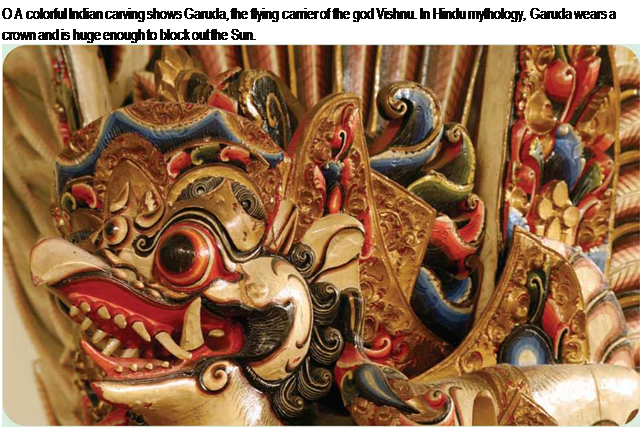Flying People
Stories about people who fly appear in cultures across the world. People of East Africa imagined Kibaga, a warrior hero, who soared over his enemies, dropping rocks on their heads. The Incas of ancient Peru told of Ayar Utso, who grew wings and flew up to the Sun. Koroglu, of Azerbaijan, mounted a horse that grew wings and carried him into the sky. Gatutkaca, from Java, had a magical jacket that allowed him to fly.
Perhaps the most famous myth about flying is the ancient Greek story of Daedalus and his son, Icarus. Daedalus had been brought by King Minos to the
island of Crete to work for him. After Daedalus helped Minos’s rival, Theseus, Daedalus knew that he and his son were in danger. For years, the two had secretly been making two pairs of wings out of eagle feathers attached to reeds by string and beeswax. Although the wings had not yet been tested, Daedalus and Icarus decided to use them to escape.
Before setting out, Daedalus warned his son not to fly too close to the sea, lest the spray of the waves wet the wings and cause him to fall. He also cautioned Icarus not to soar too high, which would allow the Sun’s heat to melt the wax and
 |
destroy the wings. With those warnings, father and son put on the wings, climbed to a tower, and launched themselves.
The two soared over the sea, but Icarus was soon overcome with the thrill of flying. Forgetting his father’s cautions, he began to climb higher and higher. Just as Daedalus had warned, the Sun’s heat melted the wax holding his wings together. As the feathers fell off his arms, Icarus plunged into the sea and drowned.
The Greek hero Perseus fared somewhat better. His quest was to kill Medusa, a monstrous woman with
JATAYU AND SAMPAATI
Hindu mythology has a story similar to that of Daedalus and Icarus. The brothers Jatayu and Sampaati were the children of the flying god Garuda. Half-gods, they had the form of vultures. The two brothers competed to see who could fly the highest. One day Jatayu soared higher than his older brother. Sampaati feared that the Sun would scorch his brother’s wings. He climbed above Jatayu to protect him. Jatayu was saved, but Sampaati’s wings were scorched off his back, causing him to fall to Earth.
______________________________________ /
SANTA CLAUS
Based on the story of a Christian saint, the legend of Santa Claus draws on elements from Holland, Germany, and Russia. Although this legend is hundreds of years old, Santa Claus’s ability to fly is rather recent. In 1823 an American named Clement Moore published a poem called "A Visit from Saint Nicholas." In the poem, Moore described how reindeer fly through the sky to take Santa from rooftop to rooftop, enabling him to reach every house. This airborne means of travel has become an important part of the Santa Claus myth.
|
О By the mid-1800s, Santa Claus, depicted here on an 1868 box of candy, had become part of the American Christmas tradition. |
_______________________________________ J
snakes for hair who was so ugly and evil that anyone who looked at her face turned to stone. With help from the
gods, Perseus obtained a pair of winged sandals that he used to fly to Medusa’s lair. He also borrowed the helmet of Hades, the god of the underworld, which made him invisible. With that ability, he could approach the monster unseen. As he arrived, Perseus looked at the monster’s reflection in his shield, rather than directly at her face. Thus protected from her power, he was able to slay her.
Perseus did not suffer any evil consequences as a result of his flying. Unlike Bellerophon, he did not risk the gods’ anger. Instead, he gave the winged sandals to the god Hermes.
The German legend of Wieland features an ironworker who fell in love with a beautiful swan-maiden. They married and lived happily for a time, but the swan-maiden yearned again for the freedom of flight and left him. Wieland was captured by an evil king who forced him to make weapons and other goods. Eventually, Wieland fashioned a suit with wings, which he used to escape from the evil king’s dungeon. After killing the king with arrows and gaining his revenge, he fulfilled his other goal by joining his swan-wife in the sky.











